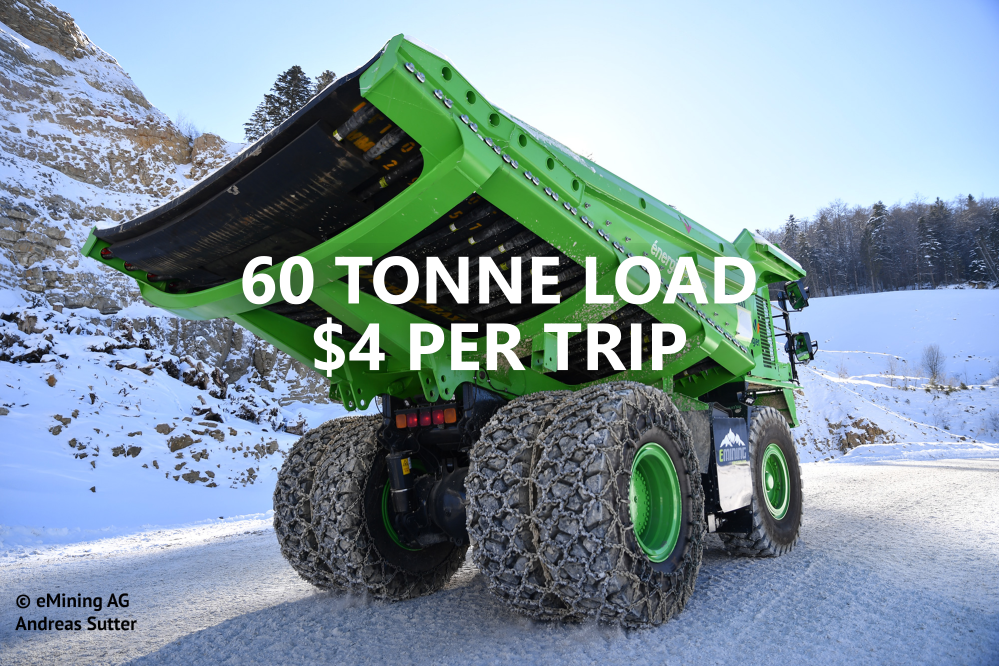Most of us will never set foot on a minesite or a commercial port, but these are the beating hearts of economies the world over. Are they a good fit for electric vehicles? With dump trucks, tug boats, and now excavators making the switch, it sure looks like it.
Energy potential
Switzerland is home to mountains, banks, cheeses, and now the world’s largest EV. With a battery 6x larger than a Tesla and 3x the power of a Formula E racer, the eDumper is a monstrous green mining machine that’s impossible to miss.
The eDumper made headlines last month for its incredible operating efficiency. Thanks to regenerative braking and the geography of its mountain minesite in Biel, it requires very little charging for its day-to-day operations.
Formula E driver Lucas di Grassi told CNN after an eDumper trip in July,
“We went out with 90% [charge], went all the way to the top, arrived with 80%, loaded up and on our way back we recovered 8%. So we got back with 88%.”
That’s not quite energy neutral, but certainly a long way from the vast quantities of diesel burned every day by combustion machines. If di Grassi is right, the 2% deficit accounts for 12kWh of the eDumper’s 600kWh battery — less than $4 worth of electricity. Compare that to the 50,000 litres of diesel the combustion alternative burns every year.
Load management
And the Swiss aren’t the only ones bringing electric vehicle tech to heavy industry. Ports of Auckland announced the purchase of the world’s first electric tug boat this month, contracting Dutch company Damen Shipyards to construct and deliver the vessel by 2021.
The e-tug will have a 70 tonne bollard pull — equal to the port’s most powerful diesel models. While it costs twice as much as the diesel equivalent at the outset, it’s two thirds reduction in operating costs are projected to be a major saving over the life of the vessel.
Auckland Mayor Phil Goff said of the purchase,
“The life of the tug is around 25 years. By going electric now, we save 25 years of diesel pollution and a net reduction in costs of around $2.5 million because it is so much cheaper to operate.”
“While we pay more up front, over the life of the tug we’ll save around $12 million in operating costs, making our electric tug cheaper in the long term,” said Ports of Auckland CEO Tony Gibson.
But what about the perennial problem for electric vehicles, range anxiety? It seems like PoA have that covered, too. Gibson confirmed,
“It was important to us that a new electric tug should be able to carry out normal port operations, just like our existing diesel tugs. Our new e-tug will be able to do three to four shipping moves on a full charge, or around three to four hours work. A fast charge will take about two hours. This is just what we need.”
So with such huge savings to be made on minesites and ports, why aren’t we seeing more electric tech in heavy industry?
Slow movers
While industrial uses for EVs are plentiful, the R&D and manufacturing required to produce them just isn’t quite there yet. Industrial vehicle manufacturers are definitely looking into post-combustion potential.
JCB, a massive manufacturer in the machinery market, are one of the first on the road to electrification. Their first fully electric model is the 19C-1E mini excavator and it’s already made its way to some customers.
JCB electric excavators on the way to customers
The JCB e-digger has a number of advantages of its combustion counterparts including a 5x noise reduction, 70% lower servicing costs, and full charge times clocking in under 2 hours.
And even when manufacturers themselves are reluctant, there are people capable of bringing electric tech where it’s needed.
Aussie company Voltra have made a name for themselves retrofitting Toyota Hiluxes with electric drivetrains for mining applications. The conversion eliminates emissions and significantly reduces noise, two of the greatest hazards for underground vehicle use in minesites worldwide.
BHP’s Olympic Dam mine employs over 800 underground employees, and last year they began trials with Voltra’s EVs to reduce emissions exposure and bring down costs at the South Australian site.
What’s next?
Many of EVs’ greatest strengths are ideal for industrial applications, and it’s only a matter of time until we see them utilised on a grand scale. The reality of massive torque on-demand, damage-resistant parts, and low operating costs are going to be too much to resist — especially with the growing cost of diesel and mounting pressure to reduce emissions.
And industrial customers aren’t afraid of high upfront costs. Mine and construction operators regularly drop millions of dollars on machines; they’re more than familiar with the economics of extracting value over time. The added cost of charging infrastructure will more than pay for itself when thousands of kilowatts are being delivered to machines daily.
At this point it’s more-or-less a waiting game. EV tech is never going to be perfect for every kind of vehicle, but the economics of many industries will inevitably push it into the mainstream over the next decade. And when it does, we’ll be here to charge them.
Check out more EV news and updates on the JET Charge blog. You can contact us at info@jetcharge.com.au with personal EV charging inquiries or follow our Facebook page for regular updates.



